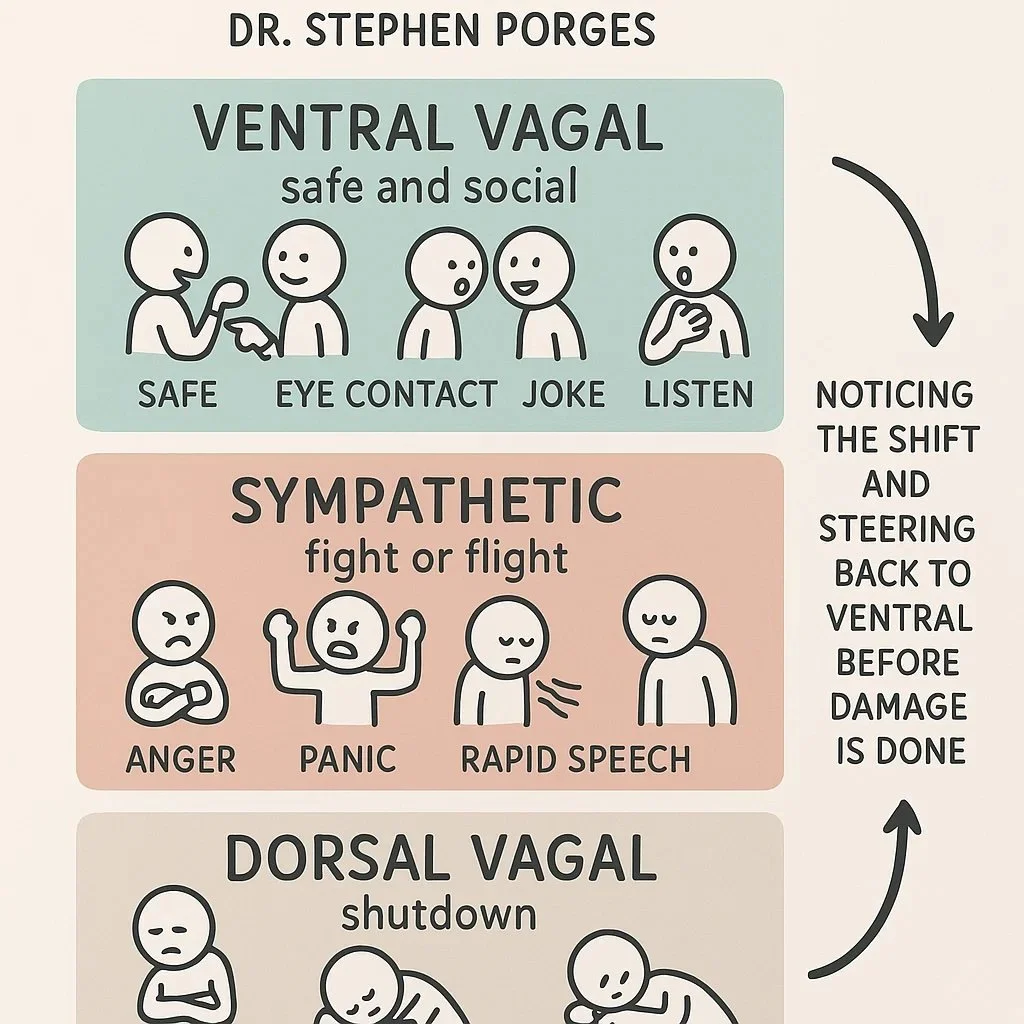Calm the Fight-or-Flight: Brain-Smart Conflict Tips
Hi everyone—Blake Anderson here, your friendly neighbourhood MSW/RSW. When I’m sitting with a couple in my office—or with an individual who’s replaying last night’s blow-up—I almost always start with the biology. When an argument tips into that white-hot fight-or-flight zone, your body floods with adrenaline and cortisol exactly the way it would if a sabre-tooth tiger lunged out of the bushes. The lower, survival layers of the triune brain hijack the show and the pre-frontal cortex—the part that plans, empathises, and problem-solves—goes dark. In Gottman language we call this emotional flooding: heart-rate above 100 bpm, tunnel vision, zero capacity to take in new information. At that point “working it out” is physiologically impossible; you’re two brains yelling through a closed door.
Gottman’s research is clear: the single best antidote is a minimum 45-minute break. I coach partners to call a time-out the moment they feel that inner siren: “I’m flooded—let’s hit pause and circle back at 6:30.” Separate rooms, a walk, a shower, a few slow belly breaths. Only after the body resets do we attempt a soft start-up: “I feel overwhelmed about the bills and I need us to look at them together tomorrow.” Soft start-ups work—but only when the nervous system is back online.
Polyvagal Theory, from Dr Stephen Porges, helps us understand why that pause matters. Our autonomic nervous system toggles between three states. In the ventral vagal state we feel safe, make eye contact, joke, and listen. Under threat we spring up into the sympathetic fight-or-flight gear—anger, panic, rapid speech. If threat feels hopeless we drop down into the dorsal vagal shutdown—stonewalling, numbness. Therapy isn’t about staying zen 24/7; it’s about noticing the shift and steering back to ventral before damage is done.
So in session I’ll pair Gottman’s concrete tools with polyvagal drills. Clients learn 4-6 breathing (inhale four, exhale six), a quick 5-4-3-2-1 grounding scan, or a simple vagus-nerve nudge—see further instructions below. These moves sound small, yet they reopen the social-engagement system so a real conversation can happen. Once calm, we circle back to the grid-locked issue, practise perspective-taking, and translate the raw emotion into a clear request.
If you and your partner keep slipping into the red zone—or if old family trauma makes every disagreement feel like an existential threat—I’d love to help. Breathe slow, take the break, and come back when your brain can actually hear love again.
1 | Why we suddenly “see red”
Even the most loving partners can shift from sweet to savage in a single remark. What’s happening under the hood?
- Fight–flight chemistry – An argument spikes adrenaline and cortisol just as surely as a caveman spotting a sabre-tooth. Blood leaves the pre-frontal cortex (planning, empathy) and rushes to the limbic “survival” circuits.
- Triune brain short-circuit – The human brain is layered: brain-stem (survival) → limbic (emotion) → cortex (reason). Under stress, traffic flows down, not up. Logical problem-solving? Offline.
- Gottman’s “emotional flooding” – John Gottman found that once heart-rate passes roughly 100 bpm, partners can no longer absorb new information. Every word sounds like attack.
Take-home: in a flooded state you’re physiologically incapable of constructive dialogue. Pushing forward just digs the trench deeper.
2 | The 45-minute rule (Gottman Method)
Gottman’s lab showed it takes about 45–60 minutes for hormones to clear and heart-rate to normalise. During that window:
- Call a time-out (“I’m flooded—let’s pause and try again at 3 p.m.”).
- Separate rooms / no ruminating – Read, stretch, breathe; do not rehearse rebuttals.
- Return with a soft start-up – After cooling, use I-feel + about + I-need: “I felt hurt during that exchange; I’d like us to slow down and listen.”
Resisting the pause—often driven by anxious attachment or “solve-it-now” conditioning—almost always backfires.
3 | Put it into practice tonight
- Agree on a cue – A hand signal or code-word means “time-out—not rejection.”
- Schedule the follow-up – Set a precise time so an anxious partner isn’t left dangling.
- Keep a ventral menu on the fridge – three breaths, one hum, one stretch.
- Journal the trigger – What younger part of me showed up? What did it need?
- If stuck, bring it to session – A neutral guide can slow the cycle and teach new moves.
Want a deeper dive?
* Couples & Co-Parents: My therapy sessions weave these tools into live practice—soft start-ups, repair attempts, and nervous-system regulation. Consider booking a consult with me.
Stay curious, breathe slow, come back to connection.
— Blake Anderson, MSW, RSW Leslieville & Virtual | Narcissistic-abuse recovery • Gottman-informed couples work




